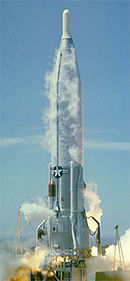Atlas SLV-3
This article includes a list of general references, but it remains largely unverified because it lacks sufficient corresponding inline citations. (October 2013) |
| Has use | Sounding rocket Expendable launch system |
|---|---|
| Manufacturer | Convair Division of General Dynamics |
| Country of origin | United States |
| Launch history | |
| Status | Retired |
| Launch sites | Cape Kennedy, LC-14 Vandenberg, SLC-3E |
| Total launches | 5 |
| Success(es) | 3 |
| Failure(s) | 2 |
| First flight | 1 June 1966 |
| Last flight | 16 August 1968 |
The Atlas SLV-3, or SLV-3 Atlas was an American expendable launch system derived from the SM-65 Atlas / SM-65D Atlas missile. It was a member of the Atlas family of rockets.
The Atlas SLV-3 was a stage and a half rocket, built as a standardized replacement for earlier Atlas launch systems, which had been derived from the various Atlas missiles.[1]
Most space launcher variants of the Atlas up to 1965 were derived from the D-series Atlas ICBM with custom modifications for the needs of the particular mission. The SLV-3 would use a standardized configuration based on the Atlas D missile for all launches with the exception of different widths for the top of the rocket depending on the upper stage being flown.
The SLV-3 had thicker gauge tank walls to support the weight of upper stages as well as upgraded engines and removal of unneeded ICBM hardware such as retrorockets. Although the main engines had greater thrust, the verniers were detuned slightly in the interest of improved ISP (vacuum specific impulse).
Variants of the SLV-3 flew until 2005 when the legacy Atlas was retired from service and replaced by the Atlas V, a completely new vehicle with conventional aircraft-style construction and different engines.
Versions[]
The following versions of the launch system were produced:[2][3]
Baseline[]

The standard Atlas-Agena vehicle is best known for launching the Augmented Target Docking Adapter (ATDA) in support of the Gemini 9A mission. This occurred on 1 June 1966, and was the first flight of the Atlas SLV-3 as an independent vehicle.[4] The ATDA failed because the payload shroud did not detach.
The rocket was also used for three suborbital tests of X-23 PRIME reentry vehicles. A leftover SLV-3 from the PRIME program was used to launch a collection of small scientific satellites from VAFB's SLC-3E on August 16, 1968.
Most Atlas-Agena SLV-3s were used for classified DoD payloads, especially KH-7 GAMBIT.
A Burner II upper stage could be used to increase payload.[5]
- Thrust (pounds): 389,000
- Booster ISP: 252.5
- Sustainer ISP: 214.2
- Vernier ISP: 190.9/237.7
- Main impulse propellants (pounds): 246,549
- Launch weight (pounds): 260,928
- Booster jettison weight (pounds): 7,368
- Sustainer jettison weight (pounds): 6,569
Revision A[]

SLV-3A was the baseline SLV-3 with extended propellant tanks for longer burn time. It was used to launch OGO-3 in 1968, all remaining launches being classified Aquacade (satellite) (Canyon/Rhyolite) SIGINT satellites. All launches took place from LC-13 at CCAS.
Revision B[]
SLV-3B was a one-off Atlas used to launch the first OAO satellite, which consisted of the SLV-3C Atlas with the Agena and payload enclosed in a full-width fairing.
Revision C[]

SLV-3C was the standard Atlas-Centaur booster, without the tapered forward section to accommodate the smaller Agena stage.
Atlas SLV-3D[]
SLV-3D had the same Atlas core as SLV-3C, with an enhanced Centaur stage.
References[]
- ^ Encyclopedia Astronautica - Atlas
- ^ "Atlas Family".
- ^ http://www.aerospaceprojectsreview.com/blog/wp-content/uploads/2014/08/Advanced-Atlas-Launch-Vehicle-Digest.pdf
- ^ "On The Shoulders of Titans - Chap. 14". Archived from the original on March 11, 2010. Retrieved October 30, 2011.
- ^ Gunter's Space Page - Atlas-SLV3 Burner-2
External links[]
- NASA Space Science Data Coordinated Archive Gemini 9 Target B
- Rockets and missiles
- Atlas (rocket family)
